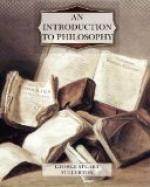The atom is not, it is true, directly perceivable by sense, but it is conceived as though it and its motions were thus perceivable. The plain man has long known that things consist of parts which remain, under some circumstances, invisible. When he approaches an object from a distance, he sees parts which he could not see before; and what appears to the naked eye a mere speck without perceptible parts is found under the microscope to be an insect with its full complement of members. Moreover, he has often observed that objects which appear continuous when seen from a distance are evidently far from continuous when seen close at hand. As we walk toward a tree we can see the indefinite mass of color break up into discontinuous patches; a fabric, which presents the appearance of an unbroken surface when viewed in certain ways may be seen to be riddled with holes when held between the eye and the light. There is no man who has not some acquaintance with the distinction between appearance and reality, and who does not make use of the distinction in common life.
Nor can it seem a surprising fact that different combinations of atoms should exhibit different properties. Have we not always known that things in combination are apt to have different properties from the same things taken separately? He who does not know so much as this is not fit even to be a cook.
No, the imperceptible world of atoms and molecules is not by any means totally different from the world of things in which the plain man lives. These little objects and groups of objects are discussed very much as we discuss the larger objects and groups of objects to which we are accustomed. We are still concerned with things which exist in space and move about in space; and even if these things are small and are not very familiarly known, no intellectual revolution is demanded to enable a man to understand the words of the scientist who is talking about them, and to understand as well the sort of reasonings upon which the doctrine is based.
9. MATHEMATICS.—Let us now turn to take a glance at the mathematical sciences. Of course, these have to do with things sooner or later, for our mathematical reasonings would be absolutely useless to us if they could not be applied to the world of things; but in mathematical reasonings we abstract from things for the time being, confident that we can come back to them when we want to do so, and can make use of the results obtained in our operations.
Now, every civilized man who is not mentally deficient can perform the fundamental operations of arithmetic. He can add and subtract, multiply and divide. In other words, he can use numbers. The man who has become an accomplished mathematician can use numbers much better; but if we are capable of following intelligently the intricate series of operations that he carries out on the paper before us, and can see the significance of the system of signs which he uses as an aid, we shall realize that he is only doing in more complicated ways what we have been accustomed to do almost from our childhood.




